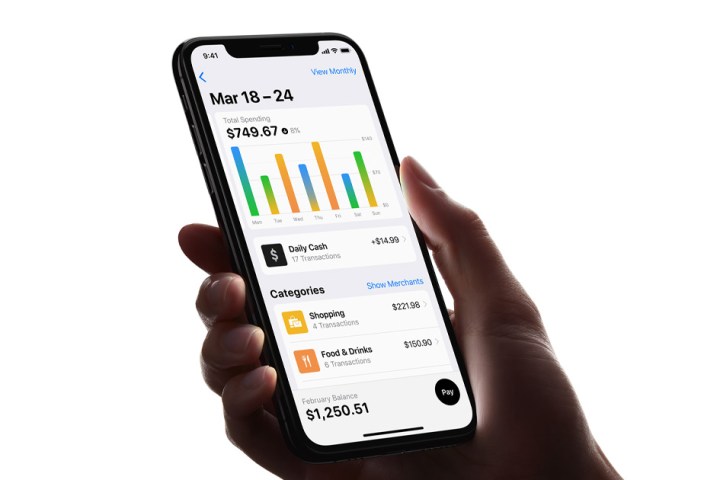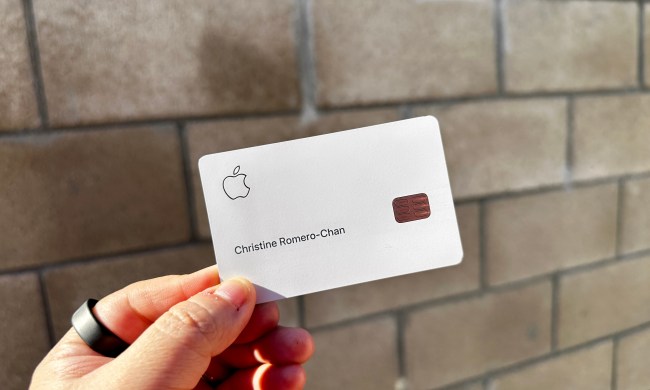
While surprise unveilings are not uncommon for Apple, the announcement of a new credit card at its March event was unexpected. The Apple Card promises no fees, cash rewards, and Apple’s trademark commitment to privacy and security. It’s housed in the Apple Wallet app, so you can use it through your iPhone or Apple Watch anywhere that accepts Apple Pay. For places that don’t accept Apple Pay, there’s the titanium physical card with your name laser etched on it.
It’s available now, sounds desirable, and is certain to attract Apple fans, but is it worth getting for the average person?
Is the Apple Card worth it?
“This depends on how you spend and on what,” Dana Marineau, vice president and financial advocate at Credit Karma, told Digital Trends. “Since the card rewards you more when you use Apple Pay, the likely target consumer is iPhone users. It may make more sense for an avid Apple fan and user to use this card — those who buy a lot of Apple products or use its subscription services, such as Apple Music, etc.”
“It may make more sense for an avid Apple fan and user to use this card.”
That’s because you get 3% cash back on Apple purchases – something Apple calls Daily Cash. If you make purchases through Apple Pay, you also get 2% cash back. Use the physical card and you get 1% cash back. But these are common rewards for cash-back credit cards. So, what’s unique or innovative about the Apple Card?
“It seamlessly integrates with your iPhone, so you can start using it within minutes of being approved,” Marineau said. “And, it has a calculator that shows you how much interest you’re taking on by paying your balance over time, and it clearly lays out your spending in an easy-to-read dashboard, giving you an added level of transparency.”
There are other advantages, too. Marineau highlights the lack of an annual fee, late fees, international fees, or over-limit fees. You can redeem Apple’s Daily Cash at Apple Pay whenever you make a purchase, even the same day. You can also use it to pay down your credit card bill or share it with your family and friends.
The trend towards mobile payments is well underway, but there’s still a gap to bridge. Apple Pay is accepted at around 70% of retail locations in the U.S., which means there’s still a decent number of places you can’t use it. That’s why it comes with the physical card backup.
“If you happen to shop at a store which doesn’t accept Apple Pay, you’ll have to swipe with your physical card,” Marineau said.
Brand loyalty
Beyond the tie-in with Apple Pay, the Apple Card is fundamentally a typical credit card. Apple partnered with Goldman Sachs and Mastercard to create it, and you’ll need a long credit history to get the best interest rate – rates vary from 13.24% to 24.24% depending on your credit score. It looks like a mutually beneficial arrangement for Apple and its partners.
“Apple is trying to carve a new niche with the Apple Card.”
“It’s a way for banks to attract a different type of audience that they wouldn’t ordinarily get,” Sara Rathner, NerdWallet’s credit card expert, said. For Apple, “It looks like they’re really trying to nudge consumers into using Apple Wallet.”
It may not be easy to persuade people to switch, though. Only 11% of credit card customers switched in 2018 and a better rewards program was the number one reason, according to J.D. Power. The marketing research firm also told us that adoption of Apple Pay is low, with just 7% of cardholders reporting that they use it.
Company-branded cards have been around for a while, especially in the travel arena with hotel chains and airlines, and another tech giant, Amazon, is also offering a credit card. But Apple’s proposition is different.
“Apple is trying to carve a new niche with the Apple Card,” Marineau said. “Instead of trying to compete with other popular travel rewards cards, Apple is making a play for brand loyalty, hoping loyal Apple customers will join.”

There’s certainly no shortage of loyal customers. Apple has sold more than 2.2 billion iPhones since it was introduced in 2007 and its amazing profit margin has made it the most valuable company in the world today. The Apple Card probably doesn’t need to be the best credit card around to attract customers.
“The card is trendy, but the rewards aren’t impressive,” Marineau said.
There are a lot of other options out there. The Citi Double Cash Card, for example, has no annual fee and pays 2% cash back on all spending. It also offers an introductory APR (annual percentage rate) of 0% on balance transfers for 18 months and then it’s 15.74% to 25.74%. Then there’s the Alliant Cashback Visa Signature Credit Card which costs nothing for the first year and pays 3% cash back on all purchases, then costs $99 per year and gives you 2.5% cash back after that. It has a variable APR of 12.49% to 14.99%.
“The card is trendy, but the rewards aren’t impressive.”
Many other cards offer specific benefits that may suit you better, but taking full advantage requires a little planning. Frequent travelers can get 2 miles back on every purchase and a one-off bonus of 50,000 miles if they spend $3,000 within 3 months of getting a Capital One Venture Rewards Credit Card. You can also enjoy a whopping 5% cash back with the Chase Freedom card on up to $1,500 in combined quarterly spending, but the categories that earn cash back change each quarter.
The Apple brand and a flashy titanium card will attract a lot of people, and for hardcore Apple fans it might pay to sign up, but most people can probably find an alternative credit card that makes more financial sense.


